Bat Removal and Control in Charlottesville, VA
OUR STAFF BIOLOGISTS KNOW HOW TO GET RID OF BATS SAFELY & HUMANELY
We are Charlottesville’s bat removal and bat control experts. We service the city of Charlottesville and all of Albemarle County – from Earlysville to Scottsville, Crozet to Keswick.
The “Blue Ridge Batman” Clement Miller and his experienced team are on call 24/7 for emergency bat removal.
Have you discovered bats in your attic, behind your shutters, or elsewhere on your property? We will humanely remove the bats and recommend or implement bat-control solutions to deter bats from returning.
Is there a bat flying around inside your house right now? Vacate the room and call us immediately. We’re always on call to remove bats from your home’s living spaces and usually can reach you in four hours or less. Do-it-yourself bat removal is not recommended.
You’ve got questions about bats. We’ve got answers…
What kind of bats are in my home?
Where do bats nest and hide?
Will bats come back?
How will I know if my house has bats and where they’re entering?
Are bats blind?
Are there many ways to eliminate bats from my home?
Do you guarantee to remove bats permanently?
How do you prevent bats from returning?
What’s the safest time to remove bats and seal my house?
Are bats a blessing or a curse?
Is there a process for bat removal?
How does the bat removal process work? Who gets the bats out?
How dangerous is bat poop (aka bat guano, bat feces)? Is it a health risk?
When do you remove bat guano?
How do you remove guano safely?
Is guano cleanup always necessary?
Can bats damage my home?
What is the best response to bat damage?
What kind of bats are in my home?
17 bat species have been recorded in Virginia. But if you have found bats in your home, they are probably one of four species.
- Little Brown Bat
- Big Brown Bat
- Evening Bat
- Brazilian Free-Tailed Bat
Where do bats nest and hide?
Agricultural, residential, and commercial properties all provide adequate and enticing habitats for bats, which require no more than ¼-inch by 1 inch to enter a structure. Once there, bats may nest, hide, and colonize anywhere dry, including:
- gable vents
- soffit returns
- ridge vents
- behind rake or trim boards
- in any obscure, dry space they can access
Will bats come back?
Once a colony has established itself in your house or on your property, it will “imprint” on the structure and return year after year.
How will I know if my house has bats and where they’re entering?
In most cases, especially with larger colonies, you can identify the entry points by watching the bats exit or discovering bat guano (bat poop), which will usually be visible below the entrance and exit points. If you’re trying to spot bats exiting your house or structure in the evening, keep in mind that not all bats exit at the same time and some nights they don’t even leave.
Are bats blind?
Contrary to urban myths, bats are not blind. In fact, they can see rather well; however, they tend to rely heavily on their echo-location abilities not only for finding insects but also for finding entry points into structures.
Effective bat removal in Charlottesville or anywhere in Albemarle County – Forest Lakes, Pantops, Ivy, Crozet, Rio, Hollymead, Free Union, Earlysville, Piney Mountain, Keswick, North Garden, Batesville, Scottsville or anywhere in between.
Please call us today at 844-WILDPRO.
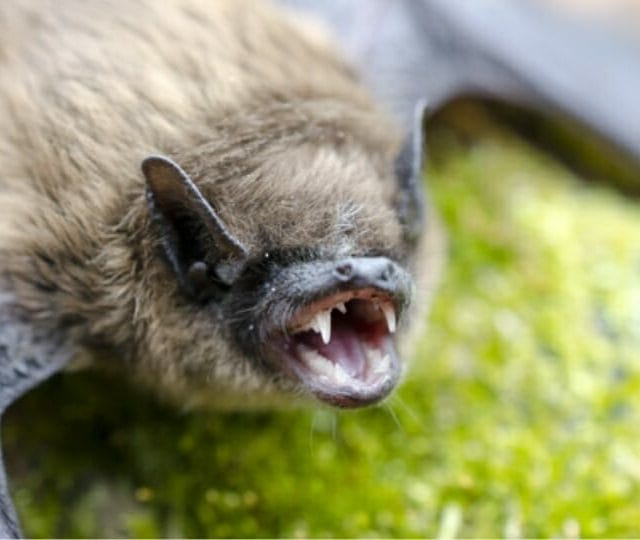
Bat Removal Techniques
BAT CONTROL GUARANTEED BY EXPERT, NWCOA BAT-CERTIFIED STAFF
Are there many ways to eliminate bats from my home?
Contrary to what you may have read online, few effective, long-term resolutions exist to remove bats from your home or business.
Do you guarantee to remove bats permanently?
Yes, our bat removal service is a guaranteed, fully warrantied solution. Our specialists adhere to the NWCOA Bat Standards by the National Wildlife Control Operators Association. Blue Ridge Wildlife & Fisheries Management is one of a handful of companies in Virginia that provides a real, permanent, and completely warrantied solution to eliminate your bat problem.
How do you prevent bats from returning?
We thoroughly inspect your home, office, or agricultural building for potential entry points. Remember, bats need only a 1″ by 1/4″ hole or gap to get in! Once all plausible entry points are identified, we close each opening using 40-year sealant, ridge vent enclosures, SS screening, or custom fabricated materials. One-way venting devices (sometimes referred to as “bat cones”) will be installed at key entry points to allow bats to exit the home naturally but not be able to re-enter.
What’s the safest time to remove bats and seal my house?
The only safe and effective time to seal your house is when there are no bats remaining inside. Sealing bat entry points when bats are still inside leads to dangerous encounters as they enter your living space to locate an escape path.
Bat Maternity and Juveniles
If the bat colony is a maternity colony with juveniles present, we must wait until the juveniles are no longer reliant upon their mothers before any venting devices can be placed.
Daytime or Nightime?
NEVER SEAL YOUR HOME AT NIGHT! Many companies will present an option to seal your home at night after the bats have exited the structure. This is a bad idea that ignores bat biology. Bats do not exit structures every evening and do not always exit at dusk. Sealing your house at night can force bats into the living space looking for a new exit.
Summer or Winter?
DO NOT SEAL YOUR HOME IN THE WINTER! This, too, does not respect the biology of bats. Bats may winter in homes or structures they inhabited in the summer. Assuming you can safely seal your home when the temperatures drop will force lingering bats into your living space.
Are bats a blessing or a curse?
Both. While bats are a truly important part of our naturally occurring ecosystem, having bats in your home can be unsettling, unpleasant, expensive, and hazardous to your health. Not only do they have a repulsive smell, carry the often misidentified bat bug, and play host to histoplasmosis via their droppings, they are also listed as one of Virginia’s primary rabies vectors. If you suspect you have a bat in your attic or anywhere inside your home, don’t wait to give us a call.
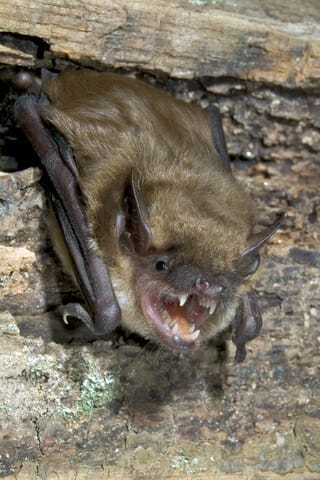
Experienced Bat Removal and Exclusion
SINCE 2011, WE HAVE REMOVED BATS AND EXCLUDED THEIR RETURN FOR THOUSANDS OF SATISFIED CUSTOMERS.
Think about that for a second. We’re guessing you’re looking for a reliable bat removal specialist near you. Maybe you’ve started searching for bat extermination or pest control companies and aren’t sure who to choose.
We perform many wildlife services – but bat exclusions are our specialty. Experience matters. To effectively remedy bat issues, professionals are almost always required due to the complexity of the job and the bat’s biology. Please do not trust this process to just anyone. Allow us to help you solve your bat problem.
Is there a process for bat removal?
Once our specialists are on-site and have diagnosed all of the potential entry points on your structure, you will be presented with a service agreement that outlines the price of the job, the areas being addressed, and the warranty being provided. This agreement will be detailed based on the distinguishable areas, photos may be provided, and a detailed explanation will follow along with available dates to perform the work. Warranty options will be available and will not be less than a minimum of one year.
How does the bat removal process work? Who gets the bats out?
We will look for bats in your attic, in your walls, in your crawlspace and everywhere throughout your home, along with examining the exterior of your home. All bat entry points will be identified and outlined in your service agreement. We get to work sealing your entire home from top to bottom based on the NWCOA Bat Standards. This means all potential entry points above 18 inches will be sealed using an array of materials and sealants. This is with the goal of your structure’s appearance remaining unchanged. Once we have completely sealed your structure, we install a one-way device on the active entry points. Effectively, the bats remove themselves and cannot re-enter.
Blue Ridge Wildlife & Fisheries Management prides itself in providing quality, aesthetically friendly bat exclusions, while also being mindful of bats’ biological tendencies. For this reason, there are sometimes during the year when juvenile bats are altricial (dependent on their parents), so we may seal your home but not include the venting device until we know that the young can fly. This typically occurs between May and August.

Bat Guano Removal (Bat Poop, Bat Feces)
WE SAFELY AND PROFESSIONALLY REMOVE BAT GUANO, BAT POOP, BAT FECES
How dangerous is bat poop (aka bat guano, bat feces)? Is it a health risk?
In addition to the unpleasant odor and staining, bat guano can be hazardous to your health. The primary danger stems from the presence of a fungal spore called Histoplasma capsalatum. Inhaling contaminated air can lead to an illness called histoplasmosis.
When do you remove bat guano?
Blue Ridge Wildlife & Fisheries Management offers guano removal when large colonies of bats have resulted in a significant accumulation of feces. We offer guano cleanups when a health risk is present. Bat guano poses health risks in several situations, which include when a household member:
-
- has autoimmune deficiencies
- is pregnant
- frequents an area with guano, such as an open-air attic
- can smell it in the living areas
- or when contaminated ductwork leads into the home.
How do you remove guano safely?
We remove guano and insulation with commercial-grade vacuums specifically designed for insulation removal. As necessary, we will wear full-face PAPR systems and create clean rooms. Once we’ve cleaned and sanitized your attic, we will reinsulate it.
Is guano cleanup always necessary?
No, and this is where we differ from the competition. If you have a small colony of bats, with very little to no guano, or it is isolated to an area you don’t access, Blue Ridge Wildlife & Fisheries Management won’t scare you. We will not recommend a cleanout or attic remediation if there is no health risk.
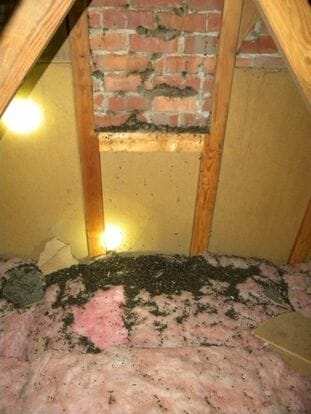
Bats and Your Health
The two most frequently associated risks with bats are rabies and histoplasmosis.
Rabies
Blue Ridge Wildlife & Fisheries Management provides rabies guidance and advice following the CDC, which states:
Rabid bats have been documented in all 49 continental states. Hawaii is rabies-free. Bats are increasingly implicated as important wildlife reservoirs for variants of rabies virus that have been transmitted to humans.
Recent data suggest that transmission of rabies virus can occur from minor, seemingly unimportant, or unrecognized bites from bats. Human and domestic animal contact with bats should be minimized, and bats should never be handled by untrained and unvaccinated persons or be kept as pets.
In all instances of potential human exposures involving bats, the bat in question should be safely collected, if possible, and submitted for rabies diagnosis. Rabies postexposure prophylaxis is recommended for all persons with bite, scratch, or mucous membrane exposure to a bat, unless the bat is available for testing and is negative for evidence of rabies.
Postexposure prophylaxis should be considered when direct contact between a human and a bat has occurred, unless the exposed person can be certain a bite, scratch, or mucous membrane exposure did not occur.
In instances in which a bat is found indoors and there is no history of bat-human contact, the likely effectiveness of postexposure prophylaxis must be balanced against the low risk such exposures appear to present. Postexposure prophylaxis can be considered for persons who were in the same room as a bat and who might be unaware that a bite or direct contact had occurred (e.g., a sleeping person awakens to find a bat in the room or an adult witnesses a bat in the room with a previously unattended child, mentally disabled person, or intoxicated person) and rabies cannot be ruled out by testing the bat. Postexposure prophylaxis would not be warranted for other household members.
It is surprisingly common to be awakened by a bat in the bedroom. By the time we arrive, you probably have taken your eye off it. Even if the bat in your room tests negative for rabies, we recommend you seek postexposure prophylaxis because unless unless you watched it constantly, there’s no way to know if the bat we captured is the same one that awoke you or another one in the colony.
Histoplasmosis
In reference to histoplasmosis, we again like to refer our customers to the CDC website. Per the CDC:
Histoplasmosis is an infection caused by a fungus called Histoplasma. The fungus lives in the environment, particularly in soil that contains large amounts of bird or bat droppings. In the United States, Histoplasma mainly lives in the central and eastern states, especially areas around the Ohio and Mississippi River valleys. The fungus also lives in parts of Central and South America, Africa, Asia, and Australia.
People can get histoplasmosis after breathing in the microscopic fungal spores from the air. Although most people who breathe in the spores don’t get sick, those who do may have a fever, cough, and fatigue. Many people who get histoplasmosis will get better on their own without medication, but in some people, such as those who have weakened immune systems, the infection can become severe.
Histoplasmosis threats can be remedied by performing thorough cleanouts. For information on bat guano cleanouts, please refer to the bat guano section of this page.
We also recommend visiting the Virginia Department of Health website.
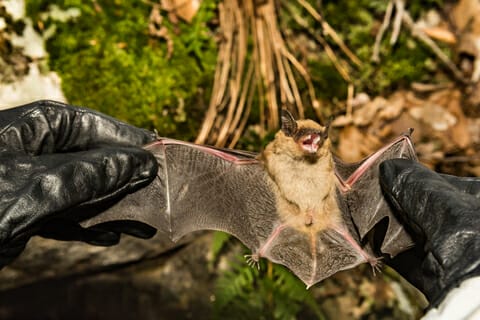
Bat Damage
HOLLYWOOD GIVES BATS A TERRIBLE REPUTATION, BUT THEY AREN’T ALL BAD.
Bats benefit the ecosystem mainly because of their voracious appetite for insects. A single bat can eat up to its body weight in insects in one night. Remember that when you are enjoying an evening on your back porch.
Can bats damage my home?
Bat damage often starts small and then escalates. Over time, bat guano and bat urine damage almost everything they touch.
Bat entries commonly begin at gable vents once the existing bug screen on the interior has been subjected to this deterioration.
So how quickly can bat waste accumulate? Well, for that, we return to a bat’s ability to ingest its body weight in a night. All that guano needs to go somewhere, and it is naturally deposited in your attic.
Once bat guano starts to accumulate rapidly, you must consider how much weight your drywall ceiling or trusses can support before more extensive damage, in addition to the smell and staining, occurs.
Bat damage can start small, with soiled insulation or a deteriorated screen. Left unchecked, wood structures begin absorbing the urine and deteriorating. If left unremedied for too long, bat damage can result in beams smelling of bat urine until they’re encapsulated, which can be costly. These signs become quite obvious upon inspection by a professional.
What is the best response to bat damage?
Proactive bat control is the best way to avoid bat damage to your home or property. Removing and excluding a colony of bats as soon as you become aware of its existence will minimize your expenses and health risks.
Call us as soon as you discover bat infestation. Being proactive is the best way to minimize bat damage!

Bat Biology
Evening Bats, Big Brown Bats, Little Brown Bats, and Brazilian-Free Tail Bats are Virginia’s most common dwelling bats. Occasionally, we’ll find a Red Bat in a home, which is rare because it is a tree species. If you’re wondering which of the four common types of bat you have, here are the identifying characteristics.

Big Brown Bat
Average Length (Adult): 3 3/4” – 5” tall.
Average Wingspread: 12 ½” – 13 3/4” wide.
Ear Height: 5/8” – ¾”
Average Adult Weight: 1/2 – 3/4 oz.
Young at Birth: 1/10 oz., pink with transparent wings and eyes closed.
2 Day: Eyes open. (Very rapid growth.)
5 Days: Hair present on back. Sooty black. Darker than adults.
3 Weeks: Start to fly.
4 – 5 Weeks: Weaned from mother.
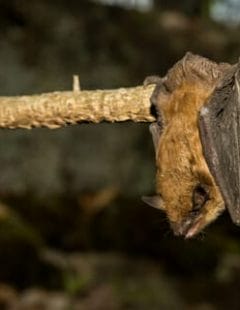
Little Brown Bat
Average Length (Adult): 3 – 3 3/4” tall.
Average Wingspread: 8 3/4” – 10 1/2” wide.
Ear Height: 1/2 – 5/8”
Average Adult Weight: 1/4 – 1/3 oz.
Young at Birth: 1/20 oz., pink with transparent wings and eyes closed.
1 Day: Eyes open. (Very rapid growth.)
5 Days: Hair present on back. Sooty black. Darker than adults.
3 Weeks: Start to fly.
6 – 9 Weeks: Weaned from mother.
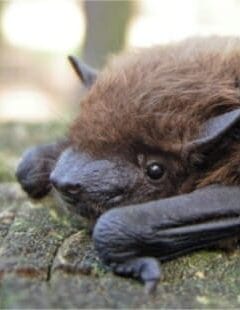
Evening Bat
Average Length (Adult): 3 5/8” – 3 3/4” tall.
Average Wingspread: 10 ¼” – 11” wide.
Ear Height: ½”
Average Adult Weight: 1/10 – 1/3 oz.
Young at Birth: 1/20 oz., pink with transparent wings and eyes closed.
1 Day: Eyes open. (Very rapid growth.)
5 Days: Hair present on back. Sooty black. Darker than adults.
3 Weeks: Start to fly.
6 – 9 Weeks: Weaned from mother.
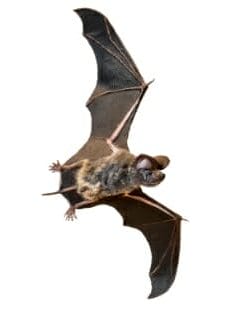
Brazilian Free-Tailed Bat
Average Length (Adult): 3 5/8” – 3 3/4” tall.
Average Wingspread: 11” wide.
Ear Height: 1/4” – 1/2”
Average Adult Weight: 3/8 – 1/2 oz.
Young at Birth: 1/10 oz., pink with transparent wings and eyes closed.
3 – 6 Weeks: Start to fly.
4 – 7 Weeks: Weaned from mother.
Do you need help with bat infestation?
Call 844-WILDPRO or 844-945-3776 today or fill out this form and someone will be in touch shortly.
Call our nearest office directly
Harrisonburg, Lexington, Staunton, Waynesboro
109 Shirey Rd
Staunton, VA 24401
(540) 520-0474
Charlottesville, Ruckersville, Scottsville, Free Union
243 Ridge McIntire Rd #1018
Charlottesville, VA 22903
(434) 422-4024
Roanoke, Bedford, Blacksburg, Covington, Smith Mountain Lake, Lynchburg
4210 Electric Rd
Roanoke, VA 24018
(540) 682-7354
Richmond, Henrico, Midlothian (804) 210-3091
"*" indicates required fields

